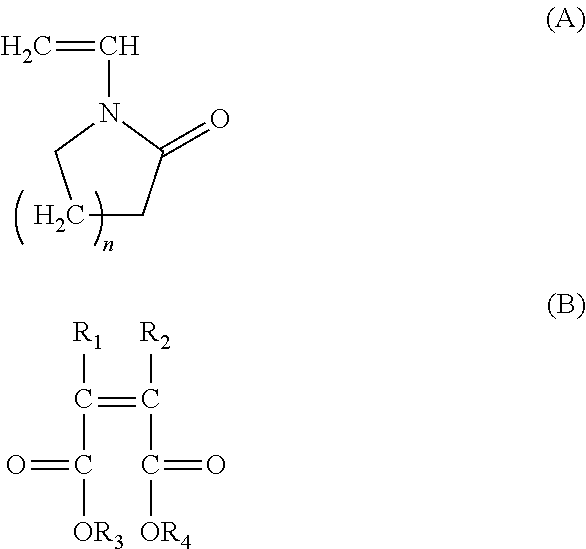Maleate-based copolymers and methods for preparing the same
a copolymer and maleate technology, applied in the field of maleate-based copolymers and methods for preparing the same, can solve the problems of cumbersome and economically undesirable procedures, affecting the resultant material properties of the intended polymer, and reducing the efficiency of the process, so as to achieve a wide range of resultant solubilities and/or mechanical properties, reduce the effect of residual monomer levels
- Summary
- Abstract
- Description
- Claims
- Application Information
AI Technical Summary
Benefits of technology
Problems solved by technology
Method used
Image
Examples
example 1
Polymerization of VP with di-2-ethylhexyl maleate in Isopropyl Acetate Solvent
[0057]29.5 g VP, 90.5 g di-2-ethylhexyl maleate and 280 g isopropyl acetate were placed in a 1000 ml three-neck round bottom flask fitted with a mechanical stirrer and cooling condenser. The reaction solution was inerted under moderate mixing with argon gas and heated to 80° C. after which 0.2335 g. 2,2′-azodi(isobutyronitrile) was added. After 3 hours, another 0.2234 g 2,2′-azodi(isobutyronitrile) was added. The reaction was allowed to react at 80° C. for a total of 18 hours. After the 18 hours, an additional 0.1828 g 2,2′-azodi(isobutyronitrile) was added, the temperature raised to 100° C. and the reaction reacted an additional 5 hours. The reaction was then cooled to room temperature and the viscous clear polymeric solution was discharged.
[0058]The resulting 30% solid's solution gave crystal clear, flexible films after drying that possessed no water solubility, but were highly soluble in various cosmeti...
example 2
Polymerization of VP with di-2-ethylhexyl maleate in Ethanol
[0060]74.25 g VP and 75.75 g di-butyl maleate were mixed together to give a clear solution (monomer mix). 50 g of this mix was added to a three-neck 1000 ml round bottom flask fitted with a mechanical stirrer, two dropping funnels, a condenser and 90 g ethanol. To the remaining 100 g monomer mix was added 50 g ethanol and placed in one of the dropping funnels. In the second dropping funnel was added a solution containing 0.73 g 2,2′-azodi(2-methylbutyronitrile) dissolved in 10 g ethanol. The entire reaction set-up and reactants were inerted with argon gas and the temperature raised to 75° C. Upon reaching 75° C., the monomer mix solution feed was added over a period of 2 hours and the initiator solution added over a period of 3 hours. The reaction was allowed to proceed for a total of 18 hours at 75° C. and then the temperature was raised to 85° C. and further reacted under slight reflux for an additional 2 hours. The polym...
example 3
Polymerization of VP with Dibutyl Maleate in Ethanol
[0062]51.75 g VP and 98.25 g di-butyl maleate were mixed together to give a clear solution (monomer mix). 50 g of this mix was added to a three-neck 1000 ml round bottom flask fitted with a mechanical stirrer, two dropping funnels, a condenser and 90 g ethanol. To the remaining 100 g monomer mix was added 50 g ethanol and placed in one of the dropping funnels. In the second dropping funnel was added a solution containing 0.60 g 2,2′-azodi(2-methylbutyronitrile) dissolved in 10 g ethanol. The entire reaction set-up and reactants were inerted with argon gas and the temperature raised to 75° C. Upon reaching 75° C., the monomer mix solution feed was added over a period of 2 hours and the initiator solution added over a period of 3 hours. The reaction was allowed to proceed for a total of 18 hours at 75° C. and then the temperature was raised to 85° C. and further reacted under slight reflux for an additional 2 hours. The polymer solut...
PUM
| Property | Measurement | Unit |
|---|---|---|
| Temperature | aaaaa | aaaaa |
| Fraction | aaaaa | aaaaa |
| Fraction | aaaaa | aaaaa |
Abstract
Description
Claims
Application Information
 Login to View More
Login to View More - R&D
- Intellectual Property
- Life Sciences
- Materials
- Tech Scout
- Unparalleled Data Quality
- Higher Quality Content
- 60% Fewer Hallucinations
Browse by: Latest US Patents, China's latest patents, Technical Efficacy Thesaurus, Application Domain, Technology Topic, Popular Technical Reports.
© 2025 PatSnap. All rights reserved.Legal|Privacy policy|Modern Slavery Act Transparency Statement|Sitemap|About US| Contact US: help@patsnap.com



